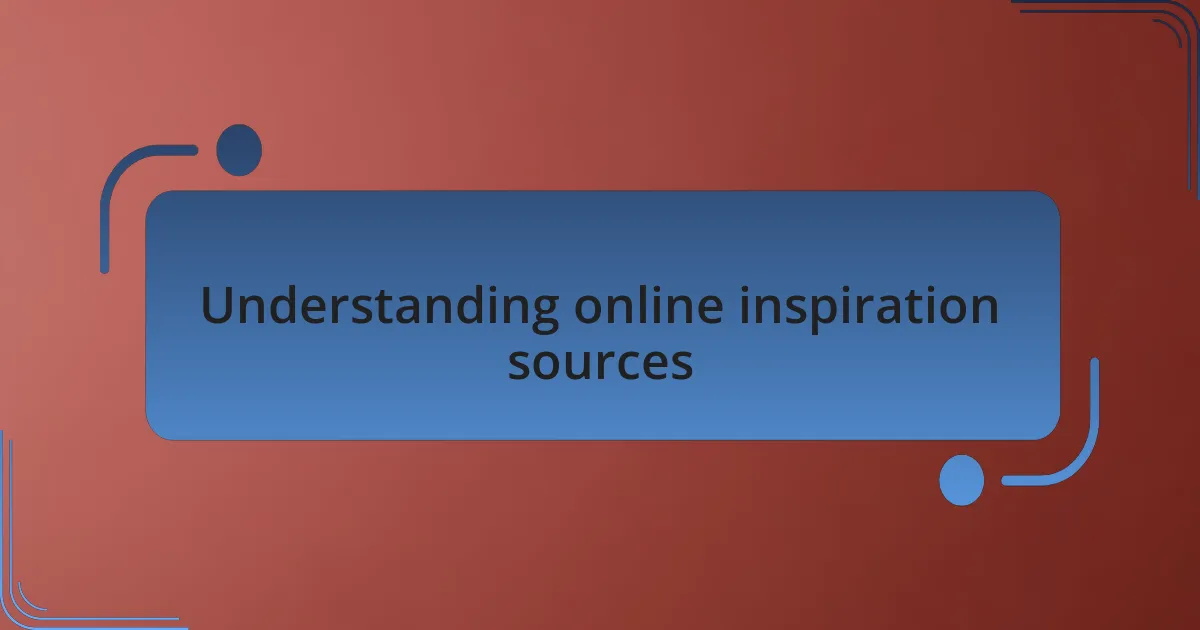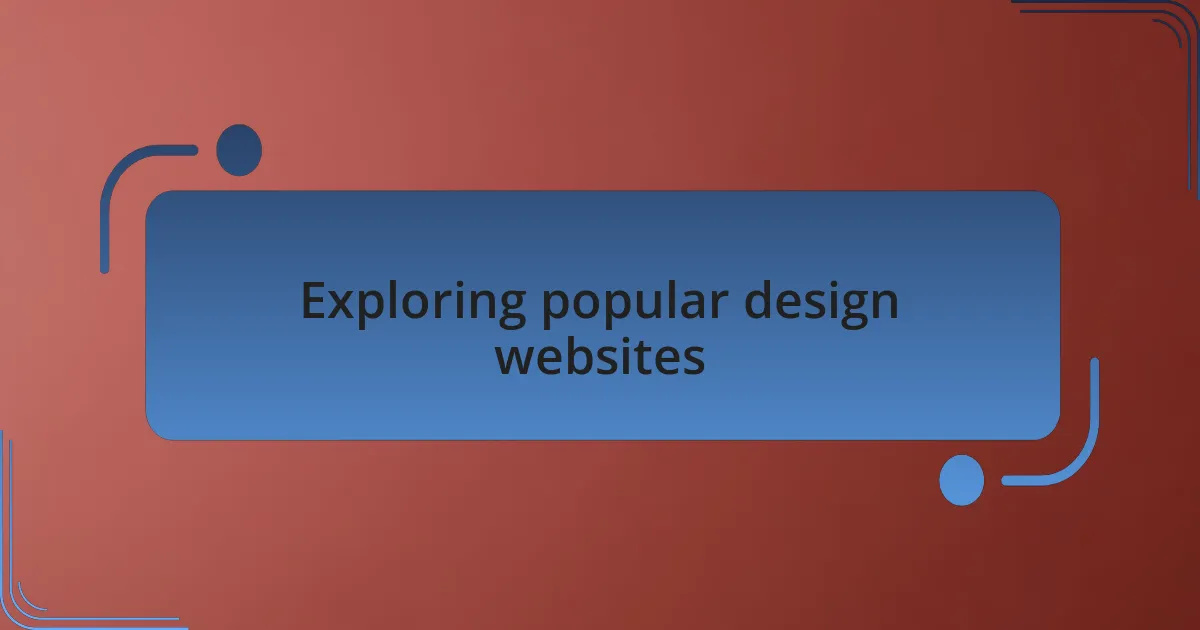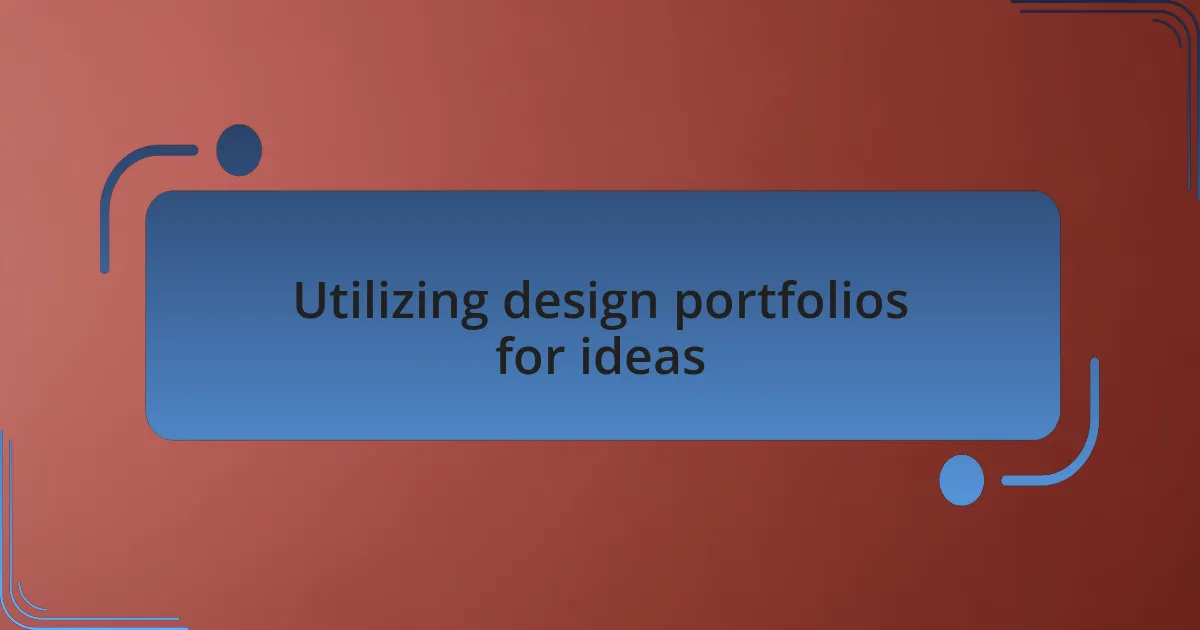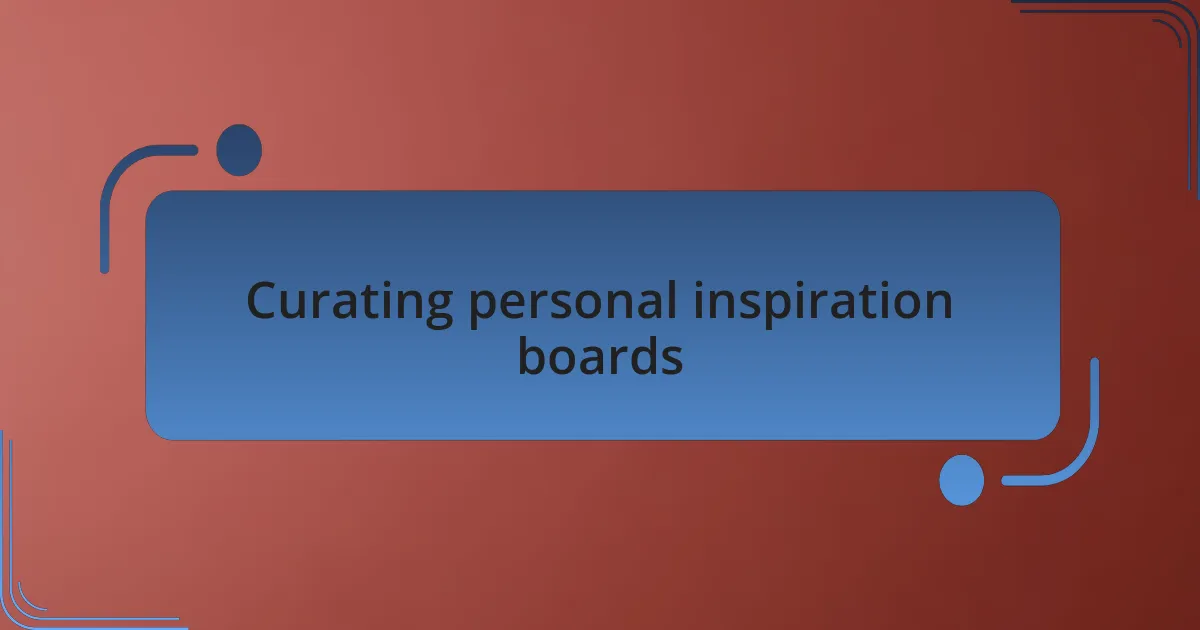Key takeaways:
- Online platforms like Pinterest, Behance, and design communities are vital sources of inspiration that can reshape creative perspectives.
- Participating in discussions and challenges within design forums fosters collaboration, sparks new ideas, and can lead to personal growth in design practices.
- Curating personal inspiration boards and documenting design experiences helps track creative evolution and refine one’s design voice.
- High-quality design portfolios reveal innovative techniques and solutions that can motivate designers to explore new approaches in their work.

Understanding online inspiration sources
When I dive into online sources for inspiration, I often find myself wandering through platforms like Pinterest and Behance. Each click exposes me to design trends that spark new ideas. It’s fascinating to see how a single color palette can ignite different concepts in my mind – have you ever experienced that creative rush when a design just resonates with you?
Social media is another treasure trove for designers seeking inspiration. I can scroll through Instagram feeds filled with stunning visuals and innovative concepts that truly inspire me. It’s incredible how a simple post can evoke emotions and trigger a flood of ideas. I remember one evening, lost in a sea of posts, when I stumbled upon a user’s unique take on minimalism, which completely shifted my perspective on clutter in web design.
Web design forums and blogs are fantastic places to not just find inspiration but also to engage in discussions. I often learn from the experiences of others, discovering what worked for them and what didn’t. Have you ever participated in such conversations? Sometimes, a shared struggle or triumph in a community can be just the nudge I need to reignite my own creativity.

Exploring popular design websites
One of my favorite design websites to explore is Awwwards, which showcases exceptional web design from around the world. The diverse array of projects often leaves me in awe, pushing the boundaries of creativity and innovation. I recall the first time I navigated through their featured designs; it was exhilarating to see how each site brilliantly combined functionality and aesthetics, and it challenged me to reassess my own work.
Dribbble is another platform I frequently visit to gather inspiration. The community-driven aspect allows designers to share their work in progress, giving insight into their creative processes. I vividly remember discovering a designer who shared their iterative sketches alongside the final product, showing me firsthand the beauty of evolution in design. It made me reflect: how often do we stop to appreciate the journey of our creative ideas?
Additionally, I constantly find myself drawn to Smashing Magazine, where insightful articles and design showcases meet. Diving into their content often fills me with fresh ideas for my projects. I once read an article on typography that completely changed my approach to text layouts; the author made me realize how the right font choice can elevate an entire design, prompting me to experiment with styles I had previously overlooked. Isn’t it fascinating how the right resources can shift our perspective?

Utilizing design portfolios for ideas
When I explore design portfolios, I’m often struck by how they can ignite the spark of creativity in unexpected ways. For instance, while browsing through Behance, I stumbled upon a minimalist website that utilized negative space so effectively that it forced me to reconsider how I use space in my own projects. Have you ever had a moment when a simple design made you feel an overwhelming urge to recreate something similar? That rush of inspiration is what keeps me returning to such platforms.
I often find that seeing high-quality, curated portfolios helps me break out of creative ruts. I once spent hours examining a series of interactive web designs that integrated animation in fresh and playful ways. Something clicked for me as I watched the seamless transitions unfold; I realized I could incorporate more motion into my projects without overwhelming the user experience. It’s remarkable how a well-executed design can reveal techniques that I might not have considered otherwise.
One of my go-to strategies is to create a mood board from my favorite designs. They don’t just serve as visual inspiration but often encapsulate a mood or feeling I want to evoke in my own work. I remember piecing together designs that shared a warm color palette and inviting typography, which helped shape the aesthetic of my latest project. Isn’t it interesting how the act of gathering various inspirations can lead to a coherent vision? Each portfolio I explore adds another layer to my understanding of design, reminding me that inspiration is just a click away.

Engaging with design communities
Engaging with design communities has been a game-changer for my creative process. I frequently participate in online forums such as Dribbble and Reddit’s web design threads, where sharing and receiving feedback feels like a breath of fresh air. Have you ever found that a simple comment from a fellow designer opened your eyes to a new perspective? It’s that kind of dialogue that truly elevates my work.
One memorable experience was during an online design challenge where participants had to create a landing page for a fictional startup. The diverse approaches I encountered sparked countless ideas I hadn’t thought possible. I remember one design that used bold typography in a way that was both playful and modern, prompting me to rethink how I approach headlines in my own projects. The thrill of seeing others push creative boundaries inspires me to step outside my comfort zone, too.
Being part of design communities often cultivates a sense of belonging that fuels my motivation. I vividly recall a late-night chat in a Discord group where we were brainstorming concepts for sustainable web design. The shared enthusiasm and passion were contagious, making me realize the importance of collaboration. Isn’t it fascinating how connecting with like-minded individuals can reignite your passion for design and lead to unexpected breakthroughs?

Curating personal inspiration boards
Curating personal inspiration boards has become an essential part of my creative toolkit. I often gather visuals, color palettes, and typography samples that resonate with me, creating a collage that reflects my aesthetic preferences and design aspirations. Have you ever stumbled upon a piece that just clicked? Sometimes, a mere image can spark a whole project or shift my design approach dramatically.
One practical method I use is digital pinning, which has made organizing my thoughts so much easier. Platforms like Pinterest allow me to save everything from website layouts to graphic elements in one place. I still remember the rush of excitement I felt when I discovered a board full of minimalistic designs that perfectly echoed my current project’s theme. Those curated collections serve as a reference point, helping me clarify my vision when I’m at a creative crossroads.
When I revisit my inspiration boards, I often find new connections that I overlooked before. It’s like seeing a treasure map with hidden paths waiting to be explored! This process not only keeps my work visually fresh but also reminds me of the evolution of my style. I find it empowering to see how my tastes have shifted over time, and it leads me to create more authentic and meaningful designs.

Documenting personal design inspirations
Documenting personal design inspirations is something I deeply value in my creative journey. I often take screenshots of websites, color schemes, or even illustrations that strike a chord with me. There’s something exhilarating about capturing that instant spark—like freezing a moment in time. Do you ever find that certain visuals resonate so strongly that they linger in your mind long after you’ve seen them?
One method I find particularly effective is journaling about my design experiences and the inspirations behind them. I keep a digital diary where I not only save images but also jot down my feelings and thoughts related to each piece. Reflecting on why something inspires me often leads to unexpected insights. Have you considered how writing down your reactions can enhance your design skills?
In addition, revisiting my documented inspirations allows me to track patterns and themes in my creative process. I once reviewed an old sketchbook filled with ideas that I thought were fleeting. To my surprise, many elements appeared again in my recent projects! This realization is a powerful reminder that inspiration can be cyclical, making me appreciate the connections between past and present work. Discovering these threads empowers me to refine my voice as a designer.